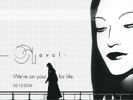Eye For Film >> Movies >> Renaissance (2006) Film Review
When a talented and ambitious young geneticist called Ilona Tasuiev (voiced by Romola Garai) is violently abducted in a car park, the DA's office turns to Barthelemy Karas (Daniel Craig), a cop unafraid to break rules or heads to solve a case.
Helped both by Ilona's older sister Bislane (Catherine McCormack) and his one-time criminal associate Farfella (Kevork Malikyan), Karas is led in his investigations to Ilona's tight-lipped elderly mentor Jonas Muller (Ian Holm) and to Ilona's employer Paul Dellenbach (Jonathan Pryce), the powerful VP at bio-cosmetics multinational Avalon. As Karas races to find out what exactly Ilona was researching and for whom, he will be drawn once again into the dark underground passageways that haunt his childhood memories.

A hardboiled detective. A kidnapped dame. A seductive sister. A dead barman. A whining informant. A corrupt industrialist. A sinister scientist. A dangerous kingpin. A femme fatale. Every one of them with a shadowy past, every one of them linked together by a convoluted conspiracy. These, the basic elements of classic film noir, are all found essentially unchanged in Christian Volckman's animated Renaissance, and even its future setting (in a glass-and-metal Paris of 2054) has been borrowed from previous SF-noir hybrids like Jean-Luc Godard's Alphaville (1965) and Ridley Scott's Blade Runner (1982) - not to mention SF-noir animes like Mamoru Oshii's Ghost in the Shell (1995) and Ghost in the Shell 2: Innocence (2004), and Shinji Aramaki's Appleseed (2004).
It is, however, in the starkness of its monochrome that Renaissance has no precedent, not even in the chiaroscuro expressionism achieved by noir's most celebrated masters. For the film's animators, unencumbered by the usual restrictions of physical lighting, have been able to start with a completely black background, and to add on absolute white when and where they like; and while they painstakingly mimic the effects of actual light sources within the frame, the contrast of black and white here is total (apart from two key scenes that feature an unexpected splash of colour). There are no grey shadings in the film's visual palette to match the characters' more equivocal moralities, and the result is a dark, dark world occasionally exposed to the most harsh and unforgiving of lights. It is the aesthetics of film noir taken to their logical extreme, and nothing before has ever looked quite like it.
All the characters in Renaissance appear to have been lifted straight from the pages of a stylised comic book drawn in black ink - but at the same time their physical reactions, their gestures and even their facial expressions seem grounded in a vivid humanity, thanks to the filmmakers' groundbreaking work with motion capture technology (including a new camera that tracks the live-action player's eye movements).
Typically films that experiment with new forms of animation let their technical innovations overshadow all other aspects of production. Sky Captain And The World Of Tomorrow, Sky Blue, Immortal and Sin City, for example, may all have looked fantastic, but left something to be desired in their plotting and characterisation.
Fortunately, however, Renaissance is blessed with a script that not only feels like genuine noir rather than a hastily written pastiche, but also is not subordinated to all the visual razzle-dazzle; and the SF elements are never allowed to get in the way of the human drama.
This combination of a striking look and a quality script help Renaissance attain the sort of immortality that so eludes its characters. Between this film and Richard Linklater's A Scanner Darkly, 2006 is shaping up to be the year in which animation at last gets the adult treatment it deserves, even beyond the shores of Asia. After decades of kiddy-film clones and more violent fare aimed strictly at teen males, this comes as a truly welcome renaissance in cinema's most flexible artform.
Reviewed on: 27 Jul 2006


















